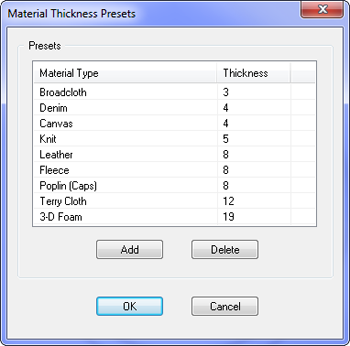Finding just the right settings or limits for your acti-feed is not always necessary, but it can make a marked improvement in sew quality and machine performance.
Sew quality and thread breaks are indicators of appropriate or inappropriate thread feed. Those symptoms are listed in sections below. The material thickness setting can either be adjusted in standard mode, or preferably, the lower limit could be adjusted in auto mode.
Material Thickness Value is Adequate When...
The material thickness does not need to be adjusted when:
- Satin and fill stitches - There is no looping or pulling on the top of a sew-out when sewing satin and fill stitches.
- Satin stitches - You can see 1/3 of bobbin showing in the middle of columns and the top color for the remainder around the sides.
- Fill Stitches - On the back of the sew-out, the top thread is even along the edge.
Increase Material Thickness When...
When not enough thread is being fed into the design, you need to increase the material thickness value. If you experience any of the following problems, you may need to perform this adjustment.
- Satin stitches - You are encountering thread breaks and you can see bobbin thread on the top of the design.
- Satin stitches - Too much bobbin is showing on the back of the design.
- Fill stitches - You can see bobbin thread on the top of the design.
- Fill stitches - There is not enough top thread showing on the back of the design.
- Registration Loss - If designs are not lining up when sewn and the cause is the thread being pulled way too tight, increasing the Material Thickness may help. Using a stable backing will also help.
Decrease Material Thickness When...
When too much thread is being fed into the design, you need to decrease the material thickness value. If you experience any of the following problems, you may need to perform this adjustment.
- Satin stitches - The stitches in the design are looping.
- Satin stitches - Not enough bobbin is showing on the back of the design.
- Fill stitches - You are encountering thread breaks and the stitches in the design are looping.
- False Bobbin Breaks - When the software detects bobbin breaks that are not really breaks, it could be that your material thickness is too high.
Acti-Feed Presets Button (Standard Mode)
In the Advanced Status tab, you can click the button for some general guidelines for Standard Acti-Feed Material Thickness. These guidelines are displayed in the following window:

To change the material thickness using these guidelines, select the material in the above window and click . The material thickness will be adjusted to match the suggestion for the material selected. You can add a new material thickness preset by the Add button and naming your own fabric and material thickness. You can also delete any of the presets. This is helpful because you may need to adjust the suggested setting, since many materials (such as denim) are available in different weights.